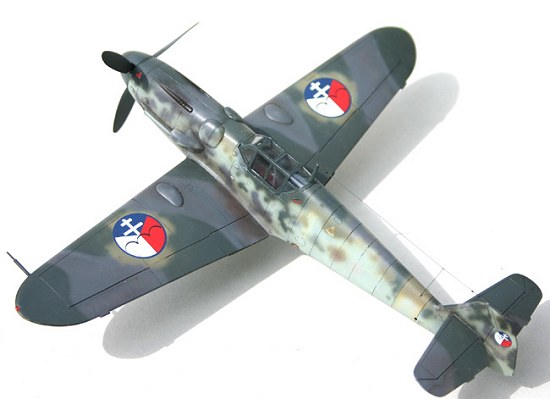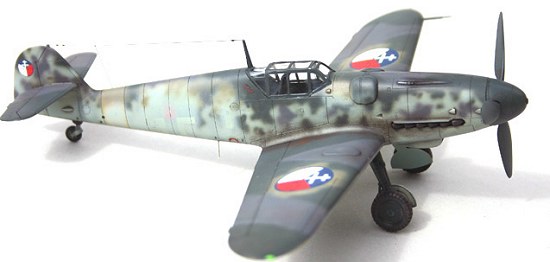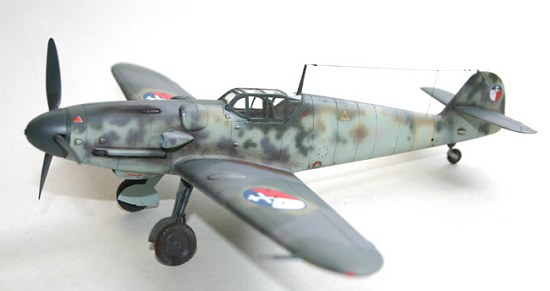
Otaki 1/48 Bf-109G-6
|
KIT # |
13 |
|
PRICE: |
@$8.00 |
|
DECALS: |
See Review |
|
REVIEWER: |
Pierre-André Boillat |
|
NOTES: |
Finish conjectural |

|
HISTORY |

What hasn’t been written about the Messerschmitt 109 ? As whole libraries could be filled with books about this mythical aircraft, I think I won’t be able to add any new technical information – and leave this job to the *real* experts. All I can say is this model depicts a Bf 109 G-6, popularly known as “Gustav” or “die Beule” – “the hump”, due to the two cowling bulges that housed the breech blocks and cocking mechanisms of the two MG 131 13mm machine guns - that replaced the smaller MG 17s of the previous versions. This particular machine is one of the 14 delivered by the Germans to the Slovak Air Force (Slovenské Vzdusné Zbrane – SVZ) in early 1944… but more on this below.
A short history of the Slovak Uprising
During WWII, several eastern European countries became Nazi Germany’s allies. Some had strategic reasons and wanted to gain back territory lost to the USSR – or were just less afraid of Hitler than they were of Stalin. Some had fallen under an ultra-nationalist or fascist party’s rule and joined the Axis forces out of political conviction, and most of them simply had the choice between marching along with Hitler or being treated like an enemy of the Reich… with quite obvious consequences.
 For the little Republic of
Slovakia – born after the annexation of the Czech Republic by Germany, it
was a mix of all these reasons : their president was Jozef Tiso, an
ultra-conservative catholic priest and fiery anti-communist (who, after
having been Hitler’s puppet for 7 years, would be ousted by the Soviets
in 1945 and eventually executed in 1947), and the country’s borders were
guaranteed by the Germans against the neighbouring countries’ territorial
appetites – so, having become a de-facto satellite of Germany, Slovakia
had to join Hitler’s “drive to the East” against the Soviet Union.
However, a large majority of the Slovak Army and population – and even
some people in the government - felt only resentment against their
“allies”, so Slovakia’s motivation was quite low, and the country was
never considered by Hitler as one his most trusty friends.
For the little Republic of
Slovakia – born after the annexation of the Czech Republic by Germany, it
was a mix of all these reasons : their president was Jozef Tiso, an
ultra-conservative catholic priest and fiery anti-communist (who, after
having been Hitler’s puppet for 7 years, would be ousted by the Soviets
in 1945 and eventually executed in 1947), and the country’s borders were
guaranteed by the Germans against the neighbouring countries’ territorial
appetites – so, having become a de-facto satellite of Germany, Slovakia
had to join Hitler’s “drive to the East” against the Soviet Union.
However, a large majority of the Slovak Army and population – and even
some people in the government - felt only resentment against their
“allies”, so Slovakia’s motivation was quite low, and the country was
never considered by Hitler as one his most trusty friends.
In April 44, it became obvious to most Slovaks that Germany was loosing the war, so the government and army command secretly started considering changing sides (the Air Force even being ordered not to engage American planes…). Ten thousands of soldiers deserted and joined the already large groups of partisans who fought against the Germans, who themselves behaved more and more like occupiers than like allies. On august 28, 1944, German troops were sent to seize control of the country and disarm the Slovak eastern army corps which was about to open the border to Soviet troops. On august 29, eventually, the insurrection was triggered by the defence minister, who declared on the state radio that the country was under attack. At once, 60’000 troops and 18’000 partisans banded together against the Nazis. Sadly, their courage and light armament alone were no match for the crack SS divisions that were sent against them, and, in spite of a fierce resistance, the uprising was crushed in 7 weeks. No help came from the Soviets, who had no interest in supporting people who surely would stand in the path of Stalin’s projects for eastern Europe. From October 44 on, the remaining soldiers and partisans retreated to the Tatra mountains and fought on until war’s end.
The Slovak “Gustavs”
Until January 1943, the SVZ’s most
powerful fighter was the Bf 109 “Emil”, which was quickly outdated by the
increasing numbers of modern soviet aircraft. On the Slovak’s request,
the fighter squadrons operating on the Russian front were then lent some
109 Fs and Gs which were used with some success. But after the battle of
Stalingrad, faith in Germany’s invincibility - and morale - started to
drop among Slovak pilots. Several desertions took place (one pilot even
defecting to the Russians with a mechanic riding in the fuselage…), so,
in late October, the “Fritzes” and “Gustavs” were seized back and the SVZ
sent home to Sl ovakia, were they had to defend the factories and the
capital, Bratislava, against US bombing raids – of course, under German
command. Having made clear to the “Jagdfliegerführer Ostmark” that they
could not intercept a B-24 or B-17 with a war-weary ‘109 E, the SVZ was
allowed to purchase 15 Bf 109 G-6s, 14 being delivered in January 1944.
ovakia, were they had to defend the factories and the
capital, Bratislava, against US bombing raids – of course, under German
command. Having made clear to the “Jagdfliegerführer Ostmark” that they
could not intercept a B-24 or B-17 with a war-weary ‘109 E, the SVZ was
allowed to purchase 15 Bf 109 G-6s, 14 being delivered in January 1944.
The only major air battle they fought took place after an incident that happened on June 16, 1944, when US bombers attacked the Apollo refineries in Bratislava. As they saw the Slovaks were not engaging the enemy (according to the secret orders received in April), some Luftwaffe officers accused the SVZ airmen of cowardice. Enraged by this insult – and their squadron leader being ill - eight Gustav pilots decided to ignore the orders and attacked a flight of B-24s and B-17s approaching Vienna on June 26, shooting down a Liberator and damaging three other bombers before being cut to pieces by the escorting P-51s and P-38s, loosing five aircraft and three pilots.
After this courageous, yet ill-advised action, only 4 Gustavs remained undamaged. Two of them were then seized by the August 29 insurgents, then flown to the Tri Duby airfield that was relatively safe from German retaliation. There, lack of fuel, spare parts and ammunition forced the Slovaks to use their only two modern interceptors very sparingly. However, the Gustavs managed to shoot down a Junkers 88 and two FW 189 reconnaissance aircraft, before being set afire on October 25 to keep them from falling into German hands.
|
THE KIT |
First released in the early 80’s, the Otaki Gustav was a pretty good kit in its days, and still has a lot to offer. I would compare it to another classic, the Monogram 109 G-10, which has nothing to be ashamed of, even after 25 years.
 So, what do you get in this box that’s
twice as small – and almost three times as cheap as the regular Hasejimi
one ?
So, what do you get in this box that’s
twice as small – and almost three times as cheap as the regular Hasejimi
one ?
Three cleanly molded sprues of light grey plastic and two transparent parts (the canopy and the Revi aiming device), all of this looking surprisingly nice, with crisply engraved panel lines. True, the detail level isn’t up to “modern” standards, especially in the wheel wells (which at least have walls) and in the cockpit area, but, given the small size of the standard 109 canopy’s windows, not much will be seen if you choose to close it (which I did, being notorious for my laziness !... besides, the headrest and armour is molded with the seat, so you have no choice if you don’t want to grab the razor saw…). A very bad standing pilot figure is also included, but this one is the worst part of the kit and won’t even be good enough for the spare box.
The exhaust pipes are quite rough, and the wheels just acceptable, being a bit thin, with overdone profiles. A choice of external loads are provided (a drop tank and two 20mm cannon gondolas), plus a tropical air filter. The decal sheet includes three Luftwaffe versions.
Of course, loads of aftermarket parts could be added, but why spend $30 of goodies on a perfectly decent $8 kit when you can buy a Fujigawa model for the same price… I hence decided to keep my wonderkits for later, have fun on this one, and give it a spectacular paint job that would hide its shortcomings…
|
CONSTRUCTION |
This little thing’s a “builder”…
…that is for sure ! After assembling, painting and weathering the cockpit and exhausts (I just added masking tape seatbelts), the little Gustav (literally dwarfed by the P-47 I was building at the same time) “jumped together” in one Sunday evening… general fit is extremely good, and almost no putty was necessary. Not a lot more is to be said… sorry to disappoint those who expected an epic report about a kit full of inbuilt booby traps requiring superhuman patience and ability… just add one “fun kit” to the Modelling Experten’s List of Infamy !
|
COLORS & MARKINGS |
 The
paint job : “under new management”
The
paint job : “under new management”
After the obligatory sanding and priming job, I decided to try the pre-shading method for the first time (thanks TC, you convinced me !). I must say it works wonders, especially on the light blue under surfaces.
My Gustav then got a standard camo of RLM 74/75/76 (with free-handed soft edges and mottling), and coated in glossy acrylic lacquer. This being done, I stood before a difficult choice, given the numerous decal sheets at hand…
As I generally try to give my models an original look – and, as I’m not a Luftwaffe hardliner, one of my ambitions being to build a whole collection of every 109 type without a single German machine, I first decided to make my 109 a “regular” SVZ aircraft… but, after applying the decals, I noticed Aeromaster had made a slight error : the separately printed red circles on the wings upper blue crosses were a bit too small, leaving a thin white edge that was impossible to correct easily. So I decided to leave the decals in place and go for the insurgent version that was also provided, and did as the Slovaks most probably did: I over-sprayed the Axis insignia and recognition marks with RLM 76 – and the ubiquitous RLM 02 green-grey, taking care of letting them shine through a little (because it looks more “business like”). Then, the Slovak insurrectional markings (the original Czechoslovak insignia with Slovakia’s three mountains and double cross in white) were applied on the over-painted areas (with the exception of the fuselage that bears no markings at all).
Being satisfied with the results, I weathered the model with a wash of burnt umbra oils that went pretty well into the deep panel lines.
|
FINAL CONSTRUCTION |
 For historical reasons, I chose
not to add any external loads, as I can figure out the Slovak insurgents
didn’t use any (most probably the German “Rüstsätze” had not been
provided, the insurgent air force suffered of lack of fuel – so drop
tanks are most unlikely, and I don’t think the precious interceptors
would have been risked on ground attack missions… no bombs in this case).
For historical reasons, I chose
not to add any external loads, as I can figure out the Slovak insurgents
didn’t use any (most probably the German “Rüstsätze” had not been
provided, the insurgent air force suffered of lack of fuel – so drop
tanks are most unlikely, and I don’t think the precious interceptors
would have been risked on ground attack missions… no bombs in this case).
The wheels, aileron weights and MG muzzles were added after all painting and weathering was done. After the final matt coat, the canopy and antenna were installed, with my usual framing job made of painted decal stripes. As it doesn’t appear on the decal sheet’s profile, the R-7 radio loop antenna was deleted. A little pastel chalk to represent the exhaust , mud and gunpowder stains… that’s all, folks !
|
CONCLUSIONS |
All in all, I’m quite happy with this little Gustav. I have several more “sexy” 109’s in my stash, but this one, with its esoteric markings representing an obscure yet meaningful event of WWII, is guaranteed to draw attention (and trigger interesting conversations) whenever displayed. As for the Otaki/Arii kit itself, I can recommend it to all those who want to add a decent Bf 109 G to their collection without emptying their wallet. Due to the release of more advanced Japanese products, it is quite easily found at swap meets, or gathering dust on some remote hobby shop’s shelves… if Airfix doesn’t re-issue it some day (as they did with several Otaki kits). Keep your eyes open !
|
REFERENCES |
« Messerschmitt 109 in Action », Squadron Signal Nr. 57
Various Internet research on the Slovak Uprising, including :
“Eagles of the Tatras” – the Slovak Air Force 1939-1945 by Jason Long on www.geocities.com
August 2004
Copyright ModelingMadness.com
If you would like your product reviewed fairly and fairly quickly, please contact the editor or see other details in the Note to Contributors.